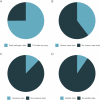Trends and Opportunities in Tick-Borne Disease Geography
- PMID: 34027972
- PMCID: PMC8577696
- DOI: 10.1093/jme/tjab086
Trends and Opportunities in Tick-Borne Disease Geography
Erratum in
-
Correction to: Trends and Opportunities in Tick-Borne Disease Geography.J Med Entomol. 2022 Nov 16;59(6):2189. doi: 10.1093/jme/tjac126. J Med Entomol. 2022. PMID: 36000478 Free PMC article. No abstract available.
Abstract
Tick-borne diseases are a growing problem in many parts of the world, and their surveillance and control touch on challenging issues in medical entomology, agricultural health, veterinary medicine, and biosecurity. Spatial approaches can be used to synthesize the data generated by integrative One Health surveillance systems, and help stakeholders, managers, and medical geographers understand the current and future distribution of risk. Here, we performed a systematic review of over 8,000 studies and identified a total of 303 scientific publications that map tick-borne diseases using data on vectors, pathogens, and hosts (including wildlife, livestock, and human cases). We find that the field is growing rapidly, with the major Ixodes-borne diseases (Lyme disease and tick-borne encephalitis in particular) giving way to monitoring efforts that encompass a broader range of threats. We find a tremendous diversity of methods used to map tick-borne disease, but also find major gaps: data on the enzootic cycle of tick-borne pathogens is severely underutilized, and mapping efforts are mostly limited to Europe and North America. We suggest that future work can readily apply available methods to track the distributions of tick-borne diseases in Africa and Asia, following a One Health approach that combines medical and veterinary surveillance for maximum impact.
Keywords: geospatial; maps; prevalence species distribution modeling; tick-borne diseases.
© The Author(s) 2021. Published by Oxford University Press on behalf of Entomological Society of America.
Figures






References
-
- Brackney, D. E., and Armstrong P. M.. . 2016. Transmission and evolution of tick-borne viruses. Curr. Opin. Virol. 21: 67–74. - PubMed
-
- Bush, L. M., and Vazquez-Pertejo. M. T.. 2018. Tick borne illness—Lyme disease. Disease-a-Month. 64: 195–212. - PubMed
-
- Bojkiewicz, E., Toczyłowski K., and Sulik A.. . 2020. Tick-borne encephalitis - a review of current epidemiology, clinical symptoms, management and prevention. Przegl. Epidemiol. 74: 316–325. - PubMed
-
- Brown, R. N., Lane R. S., and Dennis D. T.. . 2005. Geographic distributions of tick-borne diseases and their vectors, pp. 363–391. In Goodman J., Dennis D. T., and Sonenshine D. (eds.), Tick-borne diseases of humans. ASM Press, Washington, DC.
-
- Carlson, C. J. 2020. Embarcadero: Species distribution modelling with Bayesian additive regression trees in R. Methods Ecol. Evol. 11: 850–858.
Publication types
MeSH terms
Grants and funding
LinkOut - more resources
Full Text Sources
Other Literature Sources
Medical

